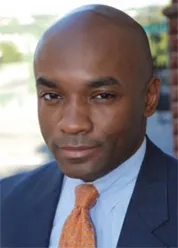The 2011 Coase Lecture: Economics and Judicial Behavior
Students come to law school hoping to learn The Law, what they may assume is a set of complex rules or codes they’ll spend three years memorizing. After arriving, they soon learn that The Law isn’t so clear cut. The manner in which judges render decisions, in particular, can sometimes seem baffling to the point of frustration, giving students temptation to conclude that judges have free reign to rule however they want, despite what the law prescribes.
That is where economics can play an important role. In the annual Coase Lecture address, Professor Thomas J. Miles told students that by applying the empirical methods used in law and economics, the academic community has uncovered patterns that explain some judicial behavior. Miles, one of the Law School’s law and economics luminaries, enlightened his audience with an overview of recent research into judicial behavior.
Many alumni will recall that the Ronald H. Coase Lecture in Law and Economics, established in 1992, features a Law School professor delivering a law and economics–themed talk presupposing no background knowledge on the topic. Although anyone can attend, the lecture is intended to give first-year students an understandable sense of law and economics’ techniques and subjects. Speakers are drawn from the Law School’s faculty and have included such greats as professors William Landes and Richard Epstein, judges Frank Easterbrook and Richard Posner, and even Ronald Coase himself.
In this year’s talk, Miles cautioned students that judges aren’t as capricious as they might imagine. The earliest studies of judicial decision making almost always focused on the Supreme Court of the United States, a court that does not handle cases that are representative of a large majority of lawsuits. Still, this early work was important for providing empirical evidence that the characteristics of judges affected outcomes.
The next generation of scholarship, much of it by economists, shifted attention to the federal circuit courts. This was beneficial because the circuit courts handle a larger number of cases than the Supreme Court and there is no discretionary docket: circuit courts must consider all cases received. Another built-in benefit was that its cases are randomly assigned, which creates a perfect experimental condition for an empirical study.
A major discovery during the early study of circuit courts was the existence of panel effects,Miles said. Research found that a judge sitting on a panel with two judges who share the same political inclinations was more likely to vote in a predictably ideological way than a judge sitting on a panel with another judge who shares those political inclinations and one who doesn’t. Former Chicago professor Cass Sunstein called this “ideological amplification.” Another standard finding was that when a judge sits with two other judges who don’t share her worldview, that judge is less likely to vote in a predictably ideological way than when sitting with at least one judge who shares viewpoints. Sunstein called this “ideological dampening.”
The idea of panel effects is so accepted that it now is a standard finding in empirical studies of judicial behavior. But Miles said the causes of panel effects aren’t so understood. This is where recent law and economics studies of judicial behavior are making progress.
One example comes from Emeritus Professor Bill Landes and Senior Lecturer and Judge Richard Posner, the giants of law and economics, in collaboration with Northwestern’s Lee Epstein, a political scientist and Supreme Court expert. Their research explained the cause of panel effects by studying what they called “dissent aversion,” Miles said. Dissent from other judges is time consuming—a judge must take time to write the dissent—and comes at a cost to the judge’s relationship with colleagues. An analysis of data from the circuit courts backed their hypothesis that judges in circuits with heavy caseloads and judges in small circuits, where judges were more likely to sit on the same panel in the near future, would dissent less frequently.
Economics was applied to federal district court judges in a study by Northwestern Law professors Max Schanzenbach and Emerson H. Tiller, published in 2008 in The University of Chicago Law Review. The two looked at how judges assign sentences to criminal defendants given the relationship between the sentencing judge’s ideological preferences and the ideological preferences of the appellate court above the sentencing judge. They found that a sentencing judge is more likely to sentence in a predictably ideological way when the circuit court and sentencing judge share the same ideological preferences. “In other words,” Miles said, “sentencing judges appear responsive to the preferences of judges who will review their decisions.”
Miles himself and his colleague Professor Adam Cox used empirical research to study how federal judges decide cases under Section 2 of the Voting Rights Act, the section that creates a private right of action by minority voters to secure their voting rights. These lawsuits often allege that electoral rules or practices dilute the vote of minority voters. The 1986 Supreme Court decision Thornburg v. Gingles established a doctrinal framework for analyzing these claims that required courts to apply both a rule and a standard. Miles and Cox studied how those doctrinal steps were applied in voting rights cases and found that ideological divisions in voting patterns were more pronounced in the standard step than in the rule step. Under the rule step, judges voted less often in an ideological way. Their results provided important support for the idea that rules limit judicial discretion.
The methods of law and economics are also being applied to assess judicial performance. In a study on judicial reputation, Professor Landes was one of the first to develop a metric by studying the number of citations of opinions authored by each judge. Now, other law and economics researchers are combining citation measures with other metrics of judges’ productivity to build metrics to rank the performance of judges. NYU Law professor Stephen Choi and Duke Law professor Mitu Gulati, along with Chicago’s own Kirkland & Ellis Professor of Law Eric Posner, produced several papers that applied this style of performance evaluation to state court judges.
Miles’s overview provided convincing evidence that the study of law and economics is being fruitfully applied to judicial behavior and thinking. First-year students were left with encouragement that while The Law isn’t as clear-cut as they might like, economics-based empirical studies help show some ways in which judicial decisions are predictable.


